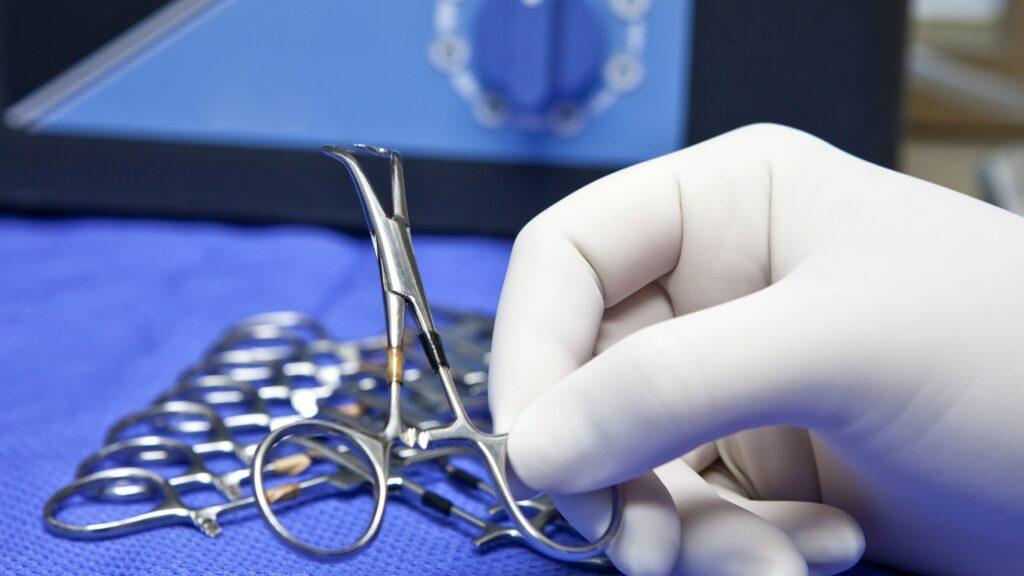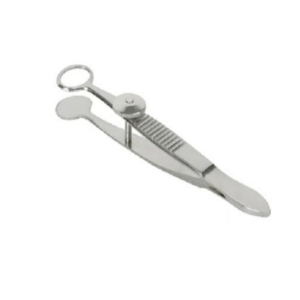In the world of surgery, precision and control are paramount. Surgeons rely on a variety of tools and techniques to ensure successful procedures and one such tool that plays a crucial role is the surgical clamps. These versatile instruments are designed to grasp, hold, and occlude tissues and vessels, allowing surgeons to perform intricate maneuvers with confidence and accuracy.
In this blog we will explore the different types of surgical clamps their features applications and benefits. From the popular Kelly forceps to specialized clamps like the mosquito forceps and bulldog clamps, we will delve into their unique designs and uncover the secrets of their usage in various medical procedures.
But before we dive into the details, let’s briefly introduce Medzell, a futuristic B2B platform dedicated to promoting Indian medical devices in emerging markets. Medzell connects healthcare providers with reliable suppliers, facilitating the distribution of high-quality medical equipment worldwide.
Understanding Surgical Clamps
Surgical clamps are specialized medical instruments designed to securely hold tissue, blood vessels, or other structures during surgical procedures. They are used to temporarily occlude or close off blood vessels, control bleeding, secure tissue, or manipulate organs during surgery. Surgical clamps are commonly made from stainless steel or other sterilizable materials and are available in various sizes and designs to be used for different surgical needs.
The primary function of surgical clamps is to provide a firm grip on the tissues or blood vessels without causing damage, allowing the surgeon to work safely and precisely. They are typically designed with serrated jaws or teeth that help to maintain a secure hold and prevent slippage. Some clamps have ratcheted handles that allow for adjustable tension and locking in place.
Different Types of Surgical Clamps
There are various types of surgical clamps each designed for specific purposes in different surgical procedures. Here are some commonly used types of surgical clamps:
- Hemostatic Clamps: These clamps are used to control bleeding by temporarily occluding blood vessels. Kelly Hemostatic Forceps clamps have straight jaws with transverse grooves or serrations for better grip. Crile Hemostatic Forceps clamps have a curved jaw and longitudinal serrations for clamping small to medium-sized vessels. Halsted Mosquito Forceps small clamps have delicate jaws with fine serrations and are used for clamping small vessels or delicate tissues.
- Tissue Clamps: These clamps are designed to securely hold and manipulate tissues during surgery. Allis Tissue Forceps clamps have multiple interlocking teeth along the jaws for a secure grip on tissue. Babcock Intestinal Forceps clamps have a gently curved jaw with a smooth surface to hold delicate tissues, such as intestines, without causing damage. Rochester-Pean Forceps clamps have a straight or curved jaw with longitudinal serrations for gripping and holding tissues during surgical procedures.
- Bulldog Clamps: These clamps have a curved shape and are commonly used for clamping larger blood vessels. Satinsky Aortic Clamp is specifically designed for clamping the aorta during cardiac surgeries. Heaney Clamp is a curved clamp with longitudinal serrations used for clamping the uterus or other organs during gynecological procedures.
- Atraumatic Clamps: These clamps have a gentler grip to minimize tissue damage during surgery. Debakey Atraumatic Vascular Clamps have broad jaws and atraumatic tips to minimize trauma to blood vessels during vascular surgery. Adson Atraumatic Tissue Forceps clamps have fine, toothless jaws with a delicate grip, ideal for handling delicate tissues in plastic surgery or ophthalmic procedures.
- Towel Clamps: These clamps are used to secure sterile drapes or towels over the surgical site. Backhaus Towel Forceps clamps have sharp, pointed tips and a ratcheted handle for secure attachment of drapes. Jones Towel Forceps clamps have rounded tips and are commonly used for securing towels or drapes in ophthalmic surgeries.
Surgical Clamp Techniques
Here are some surgical clamp techniques commonly used in various procedures:
- Atraumatic Clamping: This technique involves the use of atraumatic clamps with delicate or toothless jaws to minimize tissue damage while providing a secure grip. Atraumatic clamping is often employed in delicate procedures, such as plastic surgery or ophthalmic surgeries.
- Occlusion Technique: In this technique a clamp is applied to occlude or temporarily block the flow of blood through a vessel. It is commonly used to control bleeding or to isolate a specific area during surgery, allowing for a clearer surgical field.
- Pringle Maneuver: The Pringle maneuver involves clamping the hepatoduodenal ligament to temporarily stop the blood flow to the liver during liver surgery. This maneuver helps to reduce blood loss and improve visualization of the surgical field.
- Tourniquet Technique: A tourniquet is a device used to block blood flow temporarily to a limb during procedures. By using a tourniquet, a surgeon can minimize bleeding and maintain a bloodless field for precise surgical intervention.
- Bulldog Clamping: Bulldog clamping is a technique used to occlude larger blood vessels such as the aorta to temporarily halt blood flow. Bulldog clamps are designed with a curved shape to fit around vessels and ensure a secure grip.
- Vascular Clamping: Vascular clamping involves the use of clamps to occlude blood vessels during vascular surgeries. This technique allows surgeons to work on specific segments of vessels while maintaining blood flow in other areas.
- Jaw Clamping: Jaw clamping involves using surgical clamps with serrated jaws or teeth to securely grip and hold tissue or structures during procedures. The jaws of the clamp provide a firm grip and prevent slippage.
- Grasping Techniques: Surgical clamps, such as Allis forceps or Babcock forceps, are used to grasp and hold tissues during procedures. These clamps have interlocking teeth or smooth jaws, allowing for a secure grip without causing significant tissue damage.
- Cross-Clamping: Cross-clamping involves placing clamps across a tubular structure, such as a blood vessel or the bowel, to temporarily block or limit the flow within the structure. This technique is commonly used in cardiovascular or gastrointestinal surgeries.
- Ring Clamping: Ring clamping involves placing a surgical clamp with a ring-shaped design around a vessel or structure to occlude it. The ring provides a stable and secure grip on the tissue, ensuring controlled occlusion.
Benefits of Surgical Clamps
Here are some benefits of surgical clamps in various surgical procedures:
- Precision and Control: Surgical clamps provide surgeons with precise control over tissues, blood vessels, or structures during procedures. They allow for accurate manipulation, retraction, or occlusion, enabling surgeons to perform delicate and intricate maneuvers with increased precision.
- Blood Loss Reduction: One of the primary benefits of surgical clamps is their ability to control bleeding. By securely occluding blood vessels, clamps help minimize blood loss during surgery, which is particularly crucial in procedures where excessive bleeding can lead to complications or prolong the surgical time.
- Enhanced Tissue Manipulation: Surgical clamps facilitate the manipulation and retraction of tissues, allowing surgeons to have better access to the surgical site. By holding tissues in place, clamps provide a clear field of view and enable precise tissue dissection, suturing, or other surgical interventions.
- Time-Efficient Procedures: The use of surgical clamps can help streamline surgical procedures by providing a stable and controlled environment. Clamps ensure that tissues or structures remain in place, reducing the need for constant repositioning and saving valuable surgical time.
- Versatility in Applications: Surgical clamps come in different sizes and designs that make them suitable for versatile usage in a wide range of surgical procedures. Whether it’s controlling bleeding, securing tissues, or occluding vessels, clamps offer flexibility and adaptability in different surgical settings.
- Improved Surgical Safety: Surgical clamps enhance safety by providing a secure grip on tissues or structures. They minimize the risk of tissue slippage or accidental damage during surgical maneuvers, helping to prevent potential complications or iatrogenic injuries.
- Superior Wound Visualization: By securely holding tissues away from the surgical field, clamps improve visualization for the surgeon. This clearer view of the operating area enables surgeons to perform procedures with greater accuracy and reduces the chances of inadvertent damage to surrounding tissues.
Common Uses of Surgical Clamps
Here are common uses of surgical clamps in various surgical procedures:
- Hemostasis: Surgical clamps are frequently used to achieve hemostasis by clamping blood vessels. They help control bleeding during procedures, allowing surgeons to work in a bloodless field and ensuring better visibility. Hemostatic clamps, such as Kelly or mosquito forceps, are commonly employed for this purpose.
- Tissue Grasping: Surgical clamps are used to grasp and hold tissues during procedures. This allows surgeons to manipulate tissues, retract them, or maintain a stable position, facilitating access to the surgical site and ensuring precise surgical maneuvers. Clamps like Allis forceps or Babcock forceps are commonly used for tissue grasping.
- Tubular Structure Occlusion: Surgical clamps are employed to temporarily occlude or block tubular structures, such as blood vessels or ducts. This technique is useful for isolating specific segments controlling the flow of fluids or preventing the spread of contaminants. Cross-clamping or ring clamping techniques are commonly used for tubular structure occlusion.
- Wound Closure: Surgical clamps play a crucial role in wound closure by securely holding the edges of the wound together. This allows for precise suturing or stapling, ensuring proper wound approximation and facilitating the healing process. Various types of clamps, including tissue forceps or hemostatic clamps, may be used for wound closure.
- Tissue Approximation: Surgical clamps are used to approximate tissues during procedures. They help bring tissue edges together, facilitating suturing or other closure techniques. By holding tissues in place, clamps assist in achieving proper alignment, reducing tension on the wound, and promoting optimal healing.
- Vessel Ligation: Clamps are commonly used for vessel ligation, which involves the secure occlusion or closure of blood vessels. This technique is utilized to control blood flow, prevent bleeding, or isolate specific vessels during surgical procedures. Various types of clamps, such as bulldog clamps or vascular clamps, are employed for vessel ligation.
- Nerve Protection: Surgical clamps are used to gently grasp and protect delicate nerves during procedures. By carefully holding nerves aside or providing a stable grip, clamps help surgeons avoid inadvertent damage to neural structures, ensuring better patient outcomes.
Sterilization of Surgical Clamps
Here are short descriptions of common methods for sterilizing surgical clamps:
- Autoclave Sterilization: Surgical clamps can be sterilized using an autoclave, which uses steam under pressure to kill microorganisms. This method is widely used in healthcare facilities due to its effectiveness in achieving sterilization.
- Ethylene Oxide Sterilization: Ethylene oxide gas is commonly used to sterilize surgical instruments, including clamps. It is a low-temperature sterilization method suitable for heat-sensitive materials. Ethylene oxide effectively kills bacteria, viruses, and spores.
- Cold Sterilization: Cold sterilization also known as chemical sterilization involves immersing surgical clamps in a solution containing a sterilizing agent such as glutaraldehyde. This method is suitable for delicate or heat-sensitive instruments that cannot withstand autoclave sterilization.
- Sterile Packaging: After sterilization, surgical clamps are often individually wrapped or placed in sterile packaging to maintain their sterility until needed in the operating room. Sterile packaging helps prevent contamination during storage and transportation.
- Flash Sterilization: Flash sterilization, also called immediate use steam sterilization, is a rapid sterilization process used for urgent situations. Surgical clamps can be sterilized quickly using this method to ensure their immediate availability for emergency procedures.
- Gas Plasma Sterilization: Gas plasma sterilization also known as low temperature hydrogen peroxide plasma sterilization is a method that uses ionized gas. It is effective against microorganisms and is suitable for heat-sensitive materials.
Surgical Clamps Maintenance
Here is a brief overview of surgical clamps maintenance:
- Cleaning and Inspection: Surgical clamps should be thoroughly cleaned and inspected after each use to remove any debris, blood, or tissue residues. This helps prevent contamination and ensures proper functionality.
- Lubrication and Storage: Surgical clamps may require periodic lubrication to maintain smooth movement. After cleaning, they should be properly dried and stored in a clean and dry environment to prevent rust or damage.
- Rust Prevention: Rust can compromise the functionality and sterility of surgical clamps. Proper drying, lubrication, and storage techniques should be employed to prevent rust formation.
- Proper Handling and Care: Surgical clamps should be handled with care to avoid bending, damaging the jaws, or misaligning the working parts. They should be stored separately from other instruments to prevent scratches or dents.
- Quality Assurance: Regular quality assurance checks should be conducted to ensure that surgical clamps meet safety and performance standards. This may involve inspecting the jaws, hinges, or locking mechanisms for any signs of wear or malfunction.
- Repair and Maintenance: If any damage or malfunction is detected during inspection, surgical clamps should be promptly sent for repair or maintenance. Repairs should be carried out by authorized personnel to ensure proper functioning.
Surgical Clamps From Leading Indian Manufacturers
Umbilical Cord Clamp
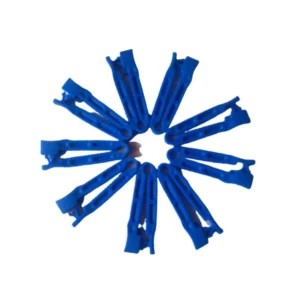 The Umbilical Cord Clamp, manufactured by Nishi Medcare in India, is a high-quality medical device designed for immediate use after birth. Crafted from premium metals and materials, it ensures secure and hygienic clamping of the umbilical cord. With a durable construction and compliance with international safety standards, it minimizes the risk of complications.
The Umbilical Cord Clamp, manufactured by Nishi Medcare in India, is a high-quality medical device designed for immediate use after birth. Crafted from premium metals and materials, it ensures secure and hygienic clamping of the umbilical cord. With a durable construction and compliance with international safety standards, it minimizes the risk of complications.
Our Umbilical Cord Clamp, tailored for newborns, is easy to handle by medical professionals. Available in various sizes, it accommodates different cord thicknesses, guaranteeing a snug fit. Its smooth, rounded edges prioritize comfort and safety, while its lightweight and portability make it ideal for any healthcare setting.
Nishi Medcare’s Umbilical Cord Clamp is an affordable solution, ensuring access to quality care in South Africa, Nigeria, and Kenya. Approved by medical experts, it reflects our commitment to excellence. In South Africa, purchase through our online store offers a convenient experience, while in Nigeria, our reliable distributors ensure accessibility. In Kenya, our superior product is the preferred choice among medical professionals.
Trust us as your supplier of choice, delivering authentic and durable Umbilical Cord Clamps. Your newborn’s safety and well-being are paramount to us.
Chalazion Clamps
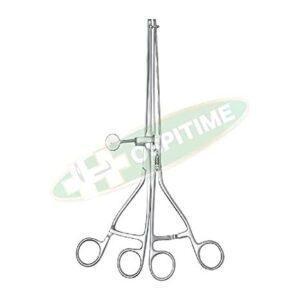 The Intestinal Clamp, Lanes Twin, manufactured by Hospitime India, is an indispensable tool in general surgeries such as partial or whole gastrectomy, intestinal resection, colectomy, and esophagectomy. This surgical clamp is constructed using surgical-grade steel, ensuring durability and reliability.
The Intestinal Clamp, Lanes Twin, manufactured by Hospitime India, is an indispensable tool in general surgeries such as partial or whole gastrectomy, intestinal resection, colectomy, and esophagectomy. This surgical clamp is constructed using surgical-grade steel, ensuring durability and reliability.
Each clamp consists of two longitudinally serrated jaws and a pin lock in the middle, enabling individual occlusion of blood flow to the viscus’s walls and lumen. With its reusable and non-sterile design, the Intestinal Clamp & Lanes Twin offers long-lasting utility. The product complies with quality standards, including the CE – Quality Mark, guaranteeing its performance and safety.
Microvascular Clamps
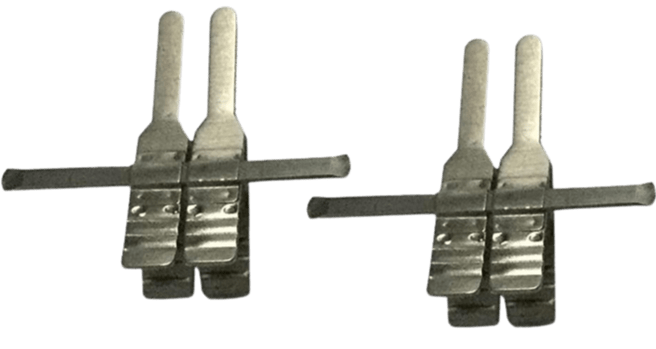 Adarsh Surgical Works presents Microvascular Clamps, precision instruments used in microsurgery techniques for clamping arteries and veins. These clamps are crafted with meticulous attention to detail, ensuring high detailing and durability. They are made from high-quality SS 304 class stainless steel with Matt and Black treatments, providing excellent rust resistance and longevity.
Adarsh Surgical Works presents Microvascular Clamps, precision instruments used in microsurgery techniques for clamping arteries and veins. These clamps are crafted with meticulous attention to detail, ensuring high detailing and durability. They are made from high-quality SS 304 class stainless steel with Matt and Black treatments, providing excellent rust resistance and longevity.
Produced using CNC machines by skilled technicians, these clamps are calibrated to perfection, guaranteeing accurate and reliable performance. The tip size is determined using digital caliper equipment, ensuring precise clamping. The Microvascular Clamps are treated with tempering and hardening in the furnace, further enhancing their durability. The product packaging options include plastic boxes, wooden boxes, and bubble wrap, ensuring secure storage and transportation.
Conclusion
Surgical clamps are indispensable tools in the operating room, enabling surgeons to perform complex procedures with precision and control. From the versatile Kelly forceps to specialized clamps like the bulldog clamps and mosquito forceps, each clamp serves a unique purpose in different surgical scenarios.
By understanding the features, applications, and benefits of surgical clamps, surgeons can optimize their techniques and ensure optimal patient outcomes. Whether it’s mastering atraumatic clamping, understanding occlusion techniques, or delving into specialized clamping methods, surgeons can enhance their skills and deliver exceptional surgical care.
As the world of surgery evolves, platforms like Medzell continue to play a significant role in promoting and connecting healthcare providers with reliable suppliers of high-quality medical devices. Medzell’s commitment to bridging the gap between Indian medical devices and emerging markets paves the way for advancements in surgical practices worldwide.
